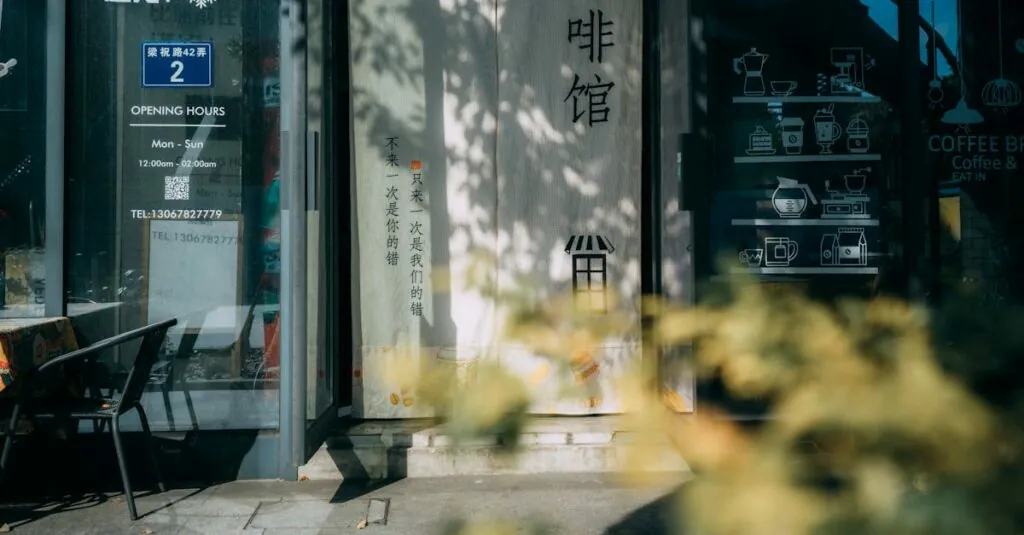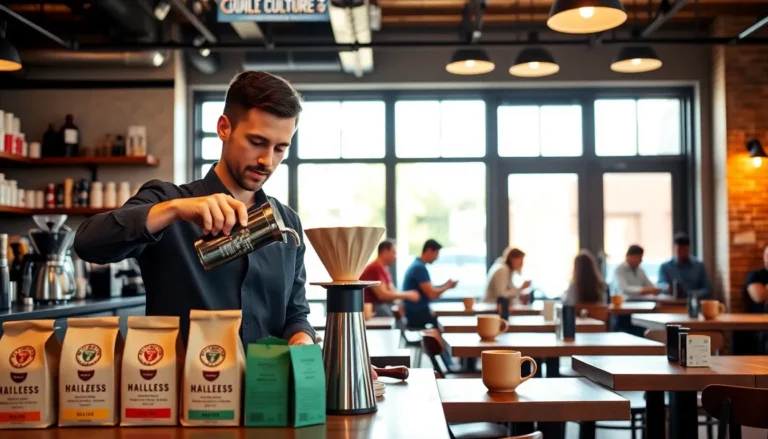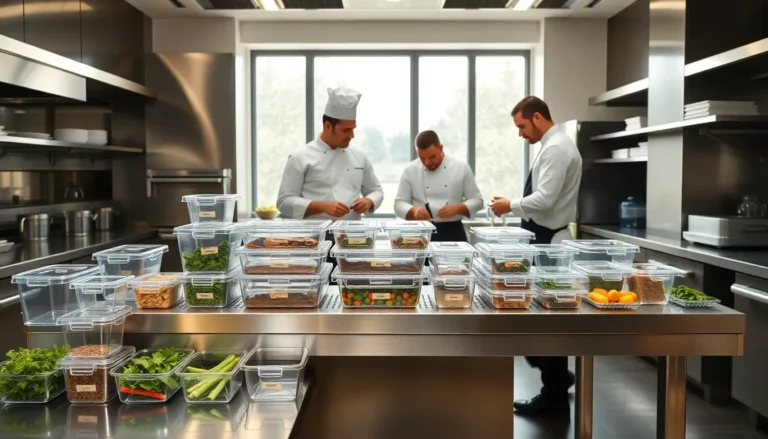Coffee culture hours are more than just a time to sip a steaming cup of joe; they’re a ritual that fuels creativity and connection. Picture this: a cozy café filled with the rich aroma of freshly brewed coffee, friends laughing over lattes, and the clatter of keyboards as work gets done. It’s a scene that’s become a daily staple for many, blending productivity with a dash of socialization.
As coffee lovers know, these hours can transform an ordinary day into an extraordinary one. From the early morning hustle to the afternoon pick-me-up, coffee culture hours offer a unique blend of energy and inspiration. So grab your favorite mug and settle in; it’s time to explore how these hours shape not just our caffeine habits but our entire social landscape.
Table of Contents
ToggleOverview of Coffee Culture Hours
Coffee culture hours represent a unique blend of social engagement and creativity. Individuals often experience invigorating moments during these hours, fostering deeper connections. Cafés, filled with lively chatter and aromatic brews, create perfect environments for collaboration and relaxation.
During peak coffee culture hours, locations may see increased foot traffic. Morning rushes frequently draw in commuters seeking their caffeine fix before heading to work. Afternoon lulls encourage students and freelancers to gather, transforming cafés into productive workspaces.
Statistics reveal that around 30% of Americans visit coffee shops weekly. This frequent patronage highlights the integral role of coffee culture hours in daily routines. A survey found that 65% of respondents appreciate the ambiance of cafés as a conducive space for both work and leisure.
Social networks often thrive during these gatherings. Friends catch up over lattes, while professionals network over espresso shots. Many individuals value the community feeling that emanates from shared coffee experiences.
Seasonal variations also influence coffee culture hours. In colder months, cozy spots fill up with groups sipping warm beverages and brainstorming ideas. Summer evenings attract a different crowd, as iced coffees and outdoor seating create an inviting atmosphere.
Overall, coffee culture hours significantly shape social dynamics and personal habits. They serve as a crucial segment of daily life, blending productivity with leisure, and allowing people to rejuvenate and connect.
The Evolution of Coffee Culture
Coffee culture has transformed significantly over the years, reflecting changing societal norms and preferences. From historical origins to contemporary practices, the journey reveals much about social interaction and community.
Historical Background
Coffee culture began in the 15th century with the first coffee houses appearing in the Middle East. These spaces served as gathering spots for conversation and debate, laying the groundwork for social interaction. By the 17th century, coffee houses spread to Europe, becoming essential for intellectual exchanges among artists and philosophers. Patrons discussed art, literature, and politics while enjoying their brews. In England, these establishments, known as “penny universities,” charged a mere penny for entry and sparked discussions that shaped public opinion. Over time, the global appreciation for coffee established rich traditions and diverse rituals, which still influence how people connect today.
Modern Trends
Modern coffee culture embraces a variety of trends, driven by consumer preferences and technology. Specialty coffee shops prioritize high-quality beans and unique brewing techniques, attracting a discerning audience. Cold brew and nitro coffee dominate menus, reflecting demand for refreshing alternatives. Additionally, cafés increasingly serve as co-working spaces, blending productivity with socializing. The rise of social media has fueled the popularity of aesthetically pleasing presentations, encouraging patrons to share their experiences online. Furthermore, seasonal offerings like pumpkin spice lattes create excitement and encourage repeat visits. According to research, approximately 30% of Americans frequent coffee shops weekly, highlighting the culture’s enduring relevance in contemporary life.
The Importance of Coffee Culture Hours
Coffee culture hours play a crucial role in enhancing both social connections and work productivity. These hours create spaces that foster creativity and lively interactions among individuals.
Social Interactions
Vibrant cafés often serve as social hubs for friends and acquaintances. Gatherings during these hours allow people to enjoy their favorite brews while engaging in meaningful conversations. Coffee houses not only facilitate connections but also empower friendships. Research indicates that approximately 30% of Americans visit coffee shops weekly, illustrating how integral these moments are to maintaining relationships. Through shared experiences, cues like laughter and conversation in cozy environments create unique memories. Seasonal variations, such as warm drinks in winter or iced coffees in summer, further entice people to connect over their shared love for coffee.
Work Productivity
Cafés often double as productive workspaces, promoting a dynamic atmosphere for freelancers and remote workers. Lively settings filled with the sound of espresso machines inspire focus and creativity. Data reveals that many people find their best ideas materialize in coffee shop environments. Spacing out work hours across different times enhances effectiveness. During peak hours, bustling activity can motivate individuals to stay productive, while quieter times offer the chance to concentrate deeply. The presence of others engaged in their tasks creates a sense of camaraderie, allowing for both personal growth and professional development in a relaxed environment.
Coffee Culture Around the World
Coffee culture varies significantly across regions, reflecting local traditions and social norms. Each country has a distinct way of enjoying coffee that influences communal experiences.
Regional Variations
Italy’s espresso bars stand out as bustling meeting spots where locals savor quick shots of coffee. In contrast, Sweden embraces “fika,” a coffee break that emphasizes social interaction over cake or pastries. Germany’s coffee scene highlights the tradition of “Kaffee und Kuchen,” where afternoon gatherings revolve around cakes and conversation. Japan’s emphasis on precision showcases meticulous brewing methods in small, serene cafés. Brazil’s coffee culture, rooted in social gatherings, often involves sipping café com leite, uniting friends in relaxation. These unique experiences illustrate how coffee serves as a universal connector, adapting to cultural preferences.
Unique Customs
In Turkey, coffee carries ritualistic significance through traditional preparation and accompanying fortune-telling. Ethiopia’s coffee ceremonies involve roasting beans in ceremonies, emphasizing communal participation and storytelling. Vietnamese coffee typically incorporates sweetened condensed milk, offering a taste variation that mirrors the vibrant street life. Greece promotes leisurely enjoyment through slow sipping of coffee, fostering extended social interactions. In Mexico, café de olla combines coffee with spices, reflecting rich culinary heritage. Each custom shapes the way communities relate to coffee, enhancing its role in social bonds.
Coffee culture hours play a vital role in shaping social interactions and enhancing personal productivity. These moments create a unique blend of connection and creativity that resonates with people across various backgrounds. As cafés continue to evolve into vibrant community hubs, they foster an environment where ideas flourish and relationships deepen.
The diverse traditions surrounding coffee highlight its universal appeal, allowing individuals to engage in meaningful experiences. Whether it’s a quick catch-up with friends or a focused work session, coffee culture hours enrich daily life and encourage a sense of belonging. Embracing these rituals can transform an ordinary day into an extraordinary one, making each sip a part of a larger story.



